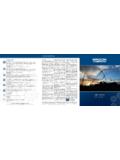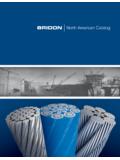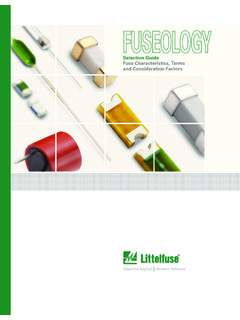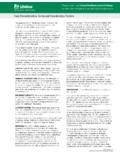Transcription of Technical Information - Bridon
1 Technical Information24 BRIDONF ibreChemical ResistanceThis table shows the residual strengths of synthetic fibres after chemical exposure under specific conditions. Contact Bridon for more detailed Information .* Steel Wire is but when lubricant / finishing is used the co-efficient may and ElasticityRope extension and elasticity are important characteristicsbecause they will determine rope behaviour in terms ofpeak loads and mooring excursions. Synthetic fibre ropesdiffer from steel because their load-extensioncharacteristics are non-linear and time overall extension of a rope is made up from severaldifferent components:Elastic Extension Elastic extension is the extension that is immediatelyrecoverable upon the release of the load.
2 In a continuouslyworking environment elastic extension will dominate therope ExtensionVisco-elastic extension is only recoverable with time afterthe release of the load. The behaviour of ropes subjected tooccasional high loads will be significantly influenced by thisvisco-elastic ExtensionPermanent extension is non-recoverable. It will occur whena new rope is first used or when a rope is subject to anunusually high load. It occurs as a result of the individualfibre components of the rope bedding in to their preferredpositions. Continuous loading of some ropes can also leadto further permanent extension due to creep at themolecular PropertiesDeg. CMaterialSpecific GravityDynamic Co-efficient ofFriction Against SteelMelting DecompositionTemperatureNylon (Polyamide)PolyesterPolypropylenePolyest er/Polyolefin Dual FibresPolyester/Polypropylene Melt MixtureHMPE (Steelite) / - - - - - *218256165140 Polyolefin256 Polyester173147 Chars @ 5001600 ChemicalConc(W/W%)(oC)(Hours)(%)TimeNylo nPolyester Polypropylene AramidHMPETemp(%)(%)(%)(%)
3 AcidsHydrochloric342010009010095100 Nitric66201000701009595 Sulphuric962010001001004090 Formic902010009510090100 Acetic10020108595100100100 AlkalisCaustic Soda40201005009090100 Caustic Soda207015010001008590 Caustic potash40201009009090100 SolventsTrichloroethylene100301501009580 100100 Carbon Tetrachloride 1002015010010010098100 Benzene100701501001001009895 Metacresol10010040010080100 Oxidising AgentHydrogen Peroxide102010001009095100 Technical Information25 BRIDONF ibreComponents of Rope ExtensionLoad-Extension characteristics of Worked RopesThe graph above compares the load-extensioncharacteristics of worked ropes but does not includepermanent StrengthStrengths are determined on new ropes under laboratoryconditions according to Bridons QA25 quality can be supplied and tested to a number ofinternational quality standards including EN 919, US MilSpecifications and Cordage Institute mass is determined by weighing a rope sample thathas been measured at a reference load.
4 For most ropes this is calculated as:Reference Load (kg) = D2/8 Where D = Rope diameter (mm)Care in useStorageRopes should be stored, where possible under deck orunder a suitable cover. The area should be clean, dry andcool out of direct sunlight. Rope should be stored off theground, to allow adequate ventilation, and away from metalwalls or steam pipes. Never store rope on concrete or dirtyfloors, or drag over rough ground - dirt and grit picked upby the rope can work into the strands cutting the insidefibres. Keep away from chemicals of all types. In the caseof long term storage used ropes should be hosed downwith fresh water to reduce salt crystals that can affect thelife and efficiency of the a rope is supplied in a coil it should always be un-coiled from the inside so the first turn comes from thebottom in a counterclockwise direction.
5 If a rope issupplied on a reel this must be allowed to freely rotate on acentral pin or pipe so that the rope can be drawn off the toplayer. Never take rope from a reel lying on its ropes can not be kinked or hockled, however, twistcan be imparted into the ropes in service. Excessive twistcan cause an imbalance between the right and left handstrands and should therefore be removed as soon aspossible by counter-rotating the rope when it is relaxed. The best method for storing a braided rope is in a figure ofeight SafetyNever stand in line with a rope under tension. If a rope fails it can recoil with sufficient force to cause serious injury or even death. Ensure all end terminations areadequate to take shock loads.
6 Use correct safety to de-rate rope strengths for incorrect end fitting and wear. Rope InspectionIn use, rope should be inspected regularly for evidence ofchemical attack (discolouration other than operationalsoiling), kinking (hockles), surface abrasion (chafe)including major yarn or strand cuts and both external andinternal strand heat fusion indicated by glazed areas orheavy fluffing and powdering. Braided ropes should be examined along their entire length for areas of stiffening or inconsistent diameter, where the rope has either flattened (necking) or has anunusual lump or surface hernia. This can indicate internaldamage or core failure due to overloading or severe shockloads. If limited to one small section the damaged areamay be cut out and re-spliced, otherwise the rope shouldbe splices and tucks for evidence of movement ormisalignment.
7 If in doubt cut off and re-splice. First Loading Worked and Rested WorkedPermanentVisco-elasticElastic ExtensionTotal Extension Steelite 12, Superline Hypamix & Supermix Superline Polyester M-Steel Winchline Fybaline Xtra Flexiline Braidline Polyester & 12 Strand Polyester Superline Nylon Braidline Nylon & 12 Strand NylonTechnical Information26 BRIDONF ibreRope installation and handling equipmentFull guidelines for rope installation and operation areavailable on request from and WinchesRopes used on single drum or split drum winches shouldbe installed under tension and the initial layers should be aclose tight fit between the flanges to prevent burying intothe lower layers. A minimum of eight wraps of rope shouldbe maintained on the drum at all should be exercised to avoid surging while thecapstan or winch head is rotating.
8 Excessive surging orslipage causes localised over heating which can melt orfuse synthetic fibres with resulting loss of possible the working or bearing position of a ropeshould be moved frequently to spread wear. The "furry"look of a well used synthetic fibre rope is not necessarily anindication of weakness. In fact the "furry" or hairy surfacecan serve to protect the CapacityPulleys and SheavesThe ratio between rope diameter and sheave diameter iscritical to the safe usage of a rope. As a general guide aratio of 8:1 minimum should be used for 8-strand, 12-strand and Braidline (Double Braid) ropes and 12:1minimum should be used for Superline ropes. The grooveof the pulley should be "U" shaped and the groove width10% greater than the rope diameter.
9 The depth of thegroove should be approximately half the rope diameter."V" shaped grooves should not be used as they tend topinch and damage the rope by increasing friction andcrushing the fibres. Sheave surfaces should be smooth andfree from burs. Sheaves should be maintained regularly sothat they are free to rotate at all BendsSharp bends around any piece of equipment should beavoided. Where a static rope passes around any surfacewith a deflection of 10 degrees or more then the diameterof the surface should be a minimum of three times the ropediameter. Any sharp bend in a rope under load willsubstsntially decrease its strength and may causepremature damage or SplicesThe length of an eye in a rope should be a minimum of threetimes, and prefereably five times, the diameter of the itemaround which it is to be passed.
10 This will ensure that the anglebetween the two legs of the eye will not cause a tearing actionat the throat of the eye. For instance if the eye of a mooring lineis passing around a 600mm diameter bollard then the eyeshould be a minimum of metres and preferably 3 metres. Retiring RopesApart from rejecting your rope when obviously damaged, it is wise to establish lifetimes of your rope within theparameters of the use for which it was selected. This willallow you to retire your rope on a regular scheduled basis,provided of course, that your conditions of usage remainunchanged. Remember to re-establish your discard criteriaif changing rope type, rope material or rope breaking of life and property is the prime consideration.





